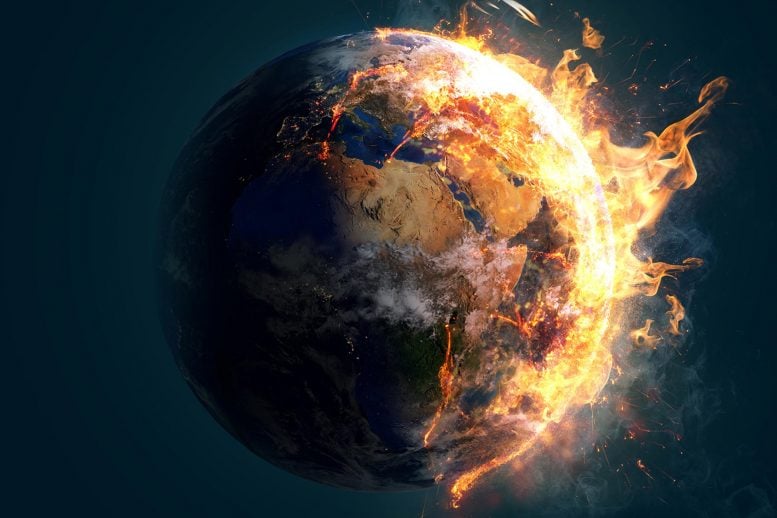
2023 is set to break global temperature records, emphasized by António Guterres’ term “global boiling.” Professor Qingxiang Li’s research using the CMST 2.0 dataset underscores the criticality of addressing the growing climate crisis.
Global temperatures are reaching alarming records, with 2023 expected to be the hottest year to date.
The climate crisis is reaching unprecedented levels of urgency as global temperatures soar to record-breaking heights, with July 2023 marking another alarming milestone. United Nations Secretary-General António Guterres declared it a “disaster for the whole planet,” emphasizing that the era of “global warming” has given way to an era of “global boiling.”
This alarming assessment is supported by recent findings from Professor Qingxiang Li’s team at the School of Atmospheric Sciences, Sun Yat-sen University, based on the China global Merged Surface Temperature dataset 2.0 (CMST 2.0). Prof. Li is also a distinguished research fellow at the Xinjiang Institute of Ecology and Geography Chinese Academy of Sciences.
Unprecedented Monthly Highs Since May
Professor Qingxiang Li’s team analyzed the CMST 2.0 dataset and discovered that 2023 has already experienced the third hottest first half-year since records began, narrowly trailing behind the warmest year in 2016 and the second warmest in 2020. The global mean sea surface temperatures (SSTs) surged to an all-time high in April, while global mean land surface air temperatures followed suit by reaching their second-highest monthly level in June. This combination resulted in May being crowned the hottest month ever recorded for global mean surface temperatures.
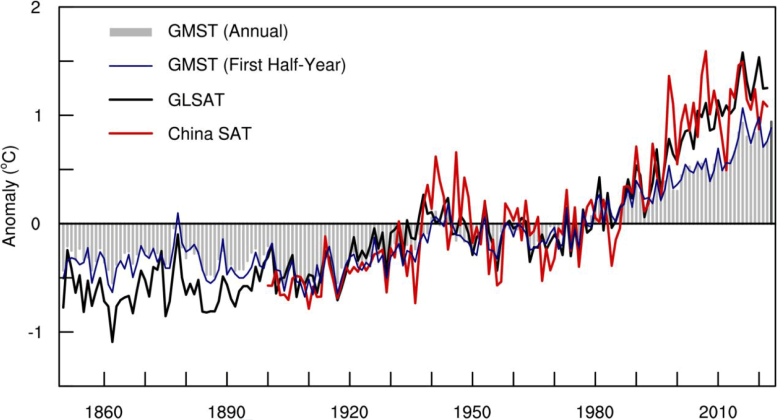
Global mean surface temperature anomalies for the whole year/first half of the year based on the CMST 2.0 (The blue line represents the GMST in the first half of the year, the gray bar represents the annual GMST (the dark gray column refers to the average predicted temperature in 2023 in the past 5 years), the black line represents the GMST, and the red line represents the regional mean ST in China). Credit: Qingxiang Li
The research further reveals that global surface temperatures continue to rise into the second half of 2023, driven by factors including El Niño and widespread wildfires. Both global mean SSTs and global mean land surface air temperatures reached unprecedented highs for July, shattering previous records. Given the current trajectory and short-term forecast results of El Niño, along with the extremely positive phase of the Atlantic Multidecadal Oscillation (AMO), which strongly influences global surface temperatures, 2023 is on track to become the hottest year on record. Moreover, 2024 may witness even higher global surface temperatures.
The research was published as a News&Views article on September 19 in Advances in Atmospheric Sciences.
The CMST 2.0 Dataset — A Global Benchmark
The CMST 2.0 dataset, developed by Professor Li Qingxiang’s team, stands as the most comprehensive global surface temperature benchmark dataset to date. It incorporates data from China, filling a critical gap in global temperature monitoring. The dataset integrates over a century’s worth of global land surface air temperature data and incorporates state-of-the-art research from across the globe, resulting in an invaluable resource for climate scientists and policymakers. In 2022, the dataset was expanded to include Arctic surface temperature data, enhancing its global coverage.
Accessible to both the scientific community and the general public, the CMST 2.0 dataset is freely available on the Global Climate Change Observation and Modeling Data Platform.

Observatory with Macao Meteorological and Geophysics Bureau. Credit: Qingxiang Li
Understanding the Complex Factors Behind Global Warming
While human activities, including greenhouse gas emissions, are the primary drivers of long-term global warming, short-term variations are influenced by internal climate system changes such as El Niño and the Pacific Decadal Oscillation (PDO). As global warming accelerates, the likelihood of extreme weather events and disasters increases, necessitating urgent action.
Global warming also has profound regional impacts, manifesting in extreme temperature fluctuations. For instance, in East Asia, circulation anomalies like the North Atlantic Oscillation (NAO) have led to frequent extreme cold events in winter, offsetting the overall rise in average temperatures. However, the rise in summer maximum temperatures and the decline in winter minimum temperatures result in larger fluctuations in extreme temperatures.
Furthermore, the pace of human discomfort due to rapid temperature increases, particularly in low-latitude regions, is a growing concern that demands our attention. The CMST 2.0 dataset and Professor Qingxiang Li’s team’s research underscore the urgency of addressing the climate crisis.
Reference: “Record-breaking High-temperature Outlook for 2023: An Assessment Based on the China Global Merged Temperature (CMST) Dataset” by Zichen Li, Qingxiang Li and Tianyi Chen, 19 September 2023, Advances in Atmospheric Sciences.
DOI: 10.1007/s00376-023-3200-9



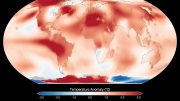

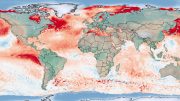
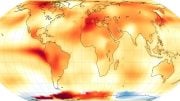

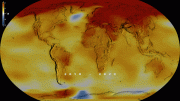
“The research was published as a News&Views article on September 19 in Advances in Atmospheric Sciences.”
A summary was also published here in SciTechDaily on September 23rd. Does a speculated approximate 0.01 deg C increase between the 2016 El Nino and this year’s El Nino really warrant weekly alarms? Their abstract actually cites both temperatures as being “approximate.” Why aren’t the error bars shown? As usual, this is little more than arm waving.
The authors assert, “As global warming accelerates, the likelihood of extreme weather events and disasters increases, …” That claim is not supported by studies:
https://www.kiteandkeymedia.com/videos/relationship-between-extreme-weather-and-climate-change/
It is also not supported by theory because the Arctic is warming 2-3X faster than the rest of the globe, reducing the temperature gradient between the Tropics and the Arctic that drives storms.
A speculated approximate 0.01c increase wouldn’t warrant weekly alarms, or any alarm. Your critical analysis of these articles is practically a public service.
My only comment on the article, it’s from the “Chinese Academy of Sciences”, run by the State Council of the Central Committee, of the Chinese Communist Party of the People’s Republic of China. China accounts for the majority of CO2 emissions in the world and growing dramatically, meanwhile the rest of the world incurs severe costs in a panicked attempt to decarbonize. Unless China changes course based on its own advice, I see this article as part of a geopolitical strategy of psychological warfare intended to hobble their competition. “Global Boiling”?
The source does raise questions about whether there might be a conflict of interests!
You said very precisely about the process of life on earth, but you should know that the surface of the earth was not that hot. It is true that the center of the core was solid when the earth was next to the star of survival and life, hundreds of billions of years ago. Last year or less, 100% of the earth separated from the unhardened and newly formed core of the survival star in the arm of the galaxy. I mean that about thirty to sixty billion years ago, when the earth, due to interactions, i.e. explosions of the core of the survival star and life in the big arm of the galaxy The core of the earth was supposed to be composed of molten, hard, and metallic materials. The core of the star of survival and life, the sponsor, you are correct in saying that the core of the earth was molten, but at that time, we can accurately guess that it was tens of billions of years ago. The star of survival and life, but in the time of tens of billions of years ago, the radius of the sun has reached such an extent that Mercury could not reach it. It is possible that the radius of the sun was four million kilometers in a hundred billion years ago. It was supposed that all the vital substances that were in oxygen, that we have 20 types of oxygen, that all plants and organisms were created from oxygen, not even all fruits were created from soil, soil is only a support for plants and trees, all the growth of plants and trees that produce fruit are created from oxygen They come and I said that oxygens have a direct effect on the growth of fruits, trunks and stems of plants, oxygens and we have maybe twenty types of oxygens and I have thought about this for decades that life on earth is an exceptional case that is very, very complex. There is, and I learned from God and his messenger exactly about the history of the earth and the fate of earthlings and the end of time through Surah Ramadan, which after ten years I just understood that if the earth was next to the sun, since the beginning of the formation of the solar system and the solar system, life would never have arisen. It happened that the earth had life, when the earth was next to the star of survival and life in the arm of the galaxy, after it cooled ten billion years ago, it had life in the form of bacteria and single cells, but it took nearly one billion years to become in seven or eight billion years. The previous year when the earth was next to the big star of survival and life
At the time when the star of survival and life had been completed and the earth had obtained all the oxygen and water necessary for life from the arm of the galaxy, before that water and oxygen were in the form of gas and clouds at a certain distance, it is exactly like crude oil. heat it in a tank and put some pipes from the bottom of the cylindrical metal tank to the top of the tank, and the materials that are in the crude oil, for example, bitumen, enter the bottom pipe, and the oil is placed in the middle of the tank and the metal cylinder, and the gas is placed at the end of the tank and It goes into the pipes above the reservoir. In a young galaxy, oxygen and water are always placed on the side of the edge of the galaxy because they are in the form of gas. Of course, this process is due to the radiation and heat of the center of the young galaxy. Heavier materials are placed in the center of the galaxy, but the gas is placed on the side of the galaxy, and at one time, water and oxygen were collected in the form of clouds and gas in the star system of survival and life from the big arms of the galaxy, and when the surface of the earth cooled a little, water and more oxygen The Milky Way galaxy is gathered in the planet Earth, but if the Earth did not come next to the Sun several million years ago, next to the Star of Survival and Life, life on Earth would never have completed its evolution at the same time that the Star of Survival and Life could not warm the Earth due to its coldness. Slowly this said star joined the solar bodies and the earth, which was placed next to the old sun with this star, life and survival on the earth became more alive next to the sun and the star that came with the earth towards the sun collided with gas planets like Jupiter and For this reason, Jupiter has been burning for several billion years. I am much more precise than these secrets that I told about life on Earth. the arm of the galaxy to the sun and after the explosion of the soil of that planet, it landed on the earth, causing dinosaurs and humans to be buried under two or three thousand meters of soil with all the structures of their cities. Millions of years ago, they were hidden under a few kilometers of soil. There is no trace of their civilization except for the shifting of the continents in the form of dinosaurs. There are no traces of the human civilization tens of millions of years ago left on the earth, that’s why today’s people never believe that they are hidden under the soil 11:57 pm iran
“… 2023 has already experienced the third hottest first half-year since records began, narrowly trailing behind the warmest year in 2016 and the second warmest in 2020.”
Incidentally, lest anyone has forgotten, 2020 was the year of the COVID shutdowns, which were most severe in the first half. The anthropogenic CO2 emissions declined, on average for the year, about 10%; April saw declines of over 14%. Yet, the atmospheric concentration of CO2, at a monthly resolution, was indistinguishable from 2019 and 2021, and the temperature of that La Nina year is tied for second place.
When the meteorites had not hit the earth, the shapes created by humans were perfect, and everyone could see from space that the Philippine Islands were the shape of a baby dinosaur that lived in the same South Asia in the ocean or in the islands themselves with humans tens of millions of years ago.
I don’t mean to name the star Baqa the sun, the system that is located in the big arm of the galaxy, before the earth came next to the sun, it was first next to the star Baqa, not next to the sun. If it was next to the sun, the earth was a hundred billion years ago, the heat of the young sun. It destroys excellent substances in 20 types of oxygen, and never a spirit or life would emerge from substances that have seen thousands of temperatures. Everything on earth is created from oxygen and water, and dust.